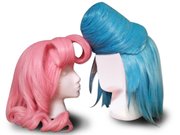Wednesday, October 23, 2013
Jackson Free Press Art Director Kristin Brenemen is quickly becoming our resident wig expert. She has made five wigs now to help take her DIY costumes to the next level. She shared her tips for transforming a wig into the perfect topper for any costume.
It's easiest to start with a base wig and build onto it. Depending on how much work you are willing to do, you can start with a cheap Halloween wig, but know that the fibers will likely be lower quality. You can also start with strips of wig hair, but you'll need some kind of base to put them on.
To color the hair on a wig, try the Sharpie method. Take a sharpie or permanent marker and let it sit in rubbing alcohol. Then, you can either soak the entire wig in a bath of the liquid or put that dyed rubbing alcohol in a spray bottle and mist the wig with it—a great way to create stripes or ombre effects. One really dedicated wig maker took the markers and literally colored on the hair strands, then sealed the color with furniture sealant (so it doesn't ruin clothes or dye your skin on contact). You can also use fabric dye much the same way as the marker liquid.
If you want to cut the wig or do a lot of heavy styling, Kristin recommends purchasing a wig form. You can get them at most beauty supply stores or even your local salon. Cut a little at a time. You can always cut more, but you can't cut less.
Adding curls or body is a great way to build volume. Most wigs are not heat-resistant, so you need to use soft curlers and hot water or steam. You need to make sure the curlers are completely cool and dry before removing them, though, so be prepared for this step to take some time.
If you really want to add some volume, you can sew two wigs together. Take one wig completely apart—the hair is sewn in lines called wefts—and sew the hair between the wefts of the intact wig.
To add shape to the wig, you can use shapes or padding and hide it under the hair. Kristin recommends using materials that are the same color as the hair (or covering your materials with felt the same color as the hair) to make disguising them easier. Use lightweight materials so your head doesn't fall backward! Foam, wire, plastic cups, etc., are all good materials. Some wig makers use paper mache, but that can get heavy if you aren't careful.
To keep the wig's shape, use fabric glue, which dries clear. It can, occasionally, stain lighter fibers, so do a test on a less visible section of the hair.
Kristin recommends wearing a wig cap, which most wig stores will throw in for free with the purchase of a wig. Even very long hair will fit under nearly any wig cap—try French braiding your hair close to the head or in a spiral around your head, then fit the wig cap over.
Final bit of advice: each step will probably take longer than you think (especially if something needs to dry), so don't delay!

